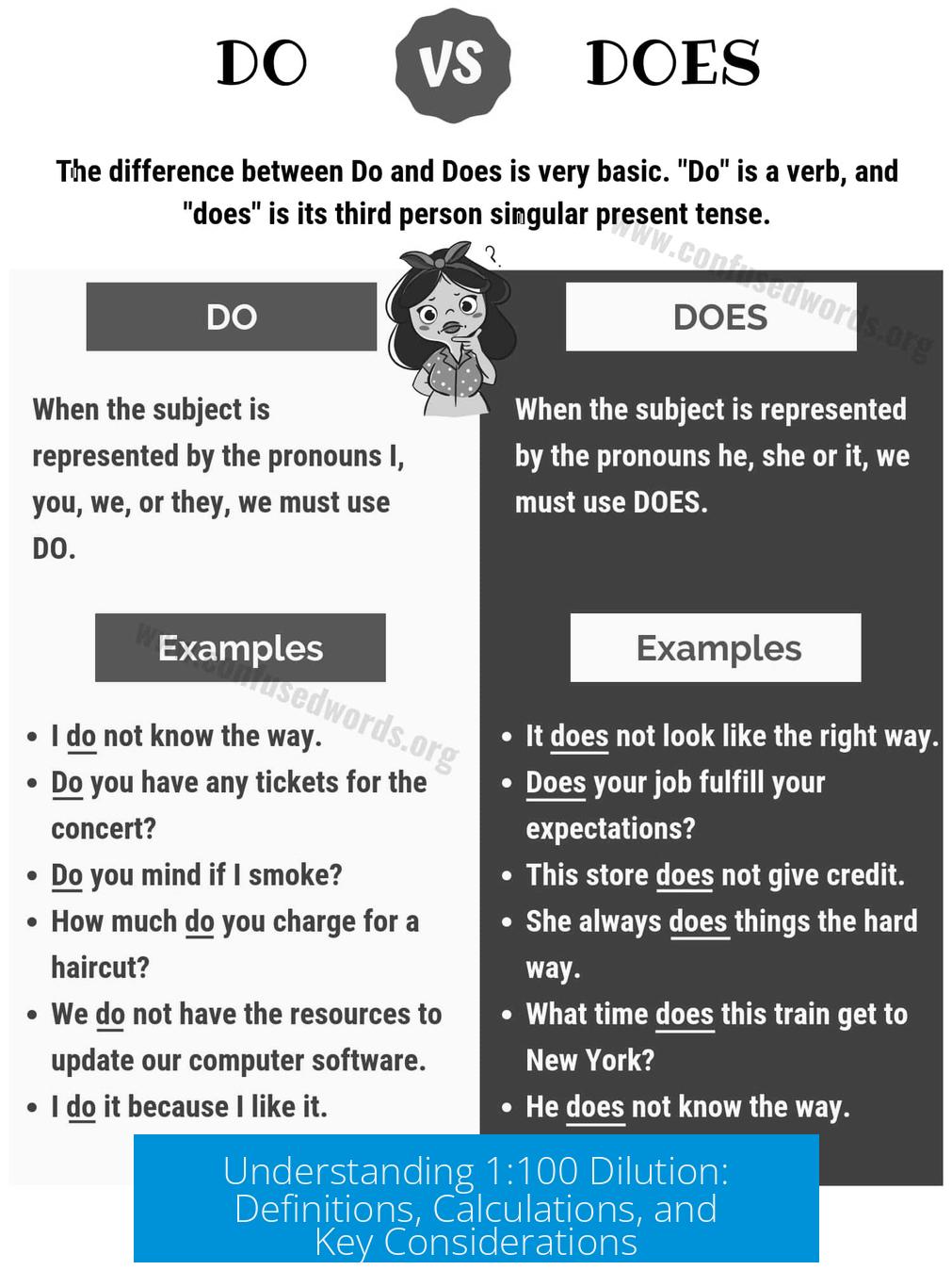What Does 1:100 Dilution Really Mean?
A 1:100 dilution commonly means mixing 1 part of a substance with 99 parts of a diluent, resulting in a total of 100 parts, thereby reducing the concentration to 1/100th of the original.
This interpretation, often called a 100-fold dilution, is used widely in experimental and analytical chemistry. However, the term “1:100 dilution” can be ambiguous, as the literal ratio suggests mixing 1 part with 100 parts diluent, totaling 101 parts. Understanding the distinction between dilution ratio and dilution factor is key to clarity.
1. Definitions and Basic Interpretations

1.1 Dilution Ratio vs Dilution Factor
There are two related but distinct ways to express dilution:
- Dilution Ratio (x:y): Represents parts of solute to parts of diluent. For 1:100, literally 1 part solute plus 100 parts diluent, total 101 parts.
- Dilution Factor (z): Describes the factor by which concentration decreases, e.g., 100-fold dilution means the final solution is 1/100th as concentrated as the original.
In practice, “1:100 dilution” typically means a dilution factor of 100—mixing 1 part of the stock solution with 99 parts diluent, yielding 100 parts total.
1.2 Common Usage and Ambiguity

The usage of “1:100” often causes confusion. Although the literal ratio implies 1+100 parts, most practitioners use it as 1+99 parts. The distinction rarely impacts experimental results at moderate dilution scales. Precision applications, however, require clear specification. Scientific texts tend to specify “1 part stock + 99 parts solvent” or “dilute to 100 parts total volume” rather than using the ambiguous “1:100” phrase alone.
1.3 Alternative Terminology for Clarity
To avoid confusion, chemists often use “100-fold dilution” instead of “1:100 dilution.” This explicitly states a 1-to-100 concentration reduction. Additionally, expressing concentrations in molarity (mol/L), weight/volume (% w/v), or explicit volumetric instructions improves clarity.
2. Mathematical and Practical Interpretations

2.1 Pure Ratio Interpretation (1:100)
Interpretting 1:100 as a pure ratio means combining 1 unit of solute with 100 units of diluent, totaling 101 units. This interpretation aligns strictly with ratio rules, but is less common in practical chemistry.
2.2 Concentration-Based Interpretation (1 in 100)

More common is interpreting 1:100 as a concentration: 1 part solute in 100 total parts of solution. This equates to mixing 1 part solute and 99 parts diluent. For example, to prepare such a solution, 1 mL stock plus 99 mL solvent gives 100 mL total volume.
In volumetric methods, one might add 1 mL stock to a volumetric flask and dilute to the 100 mL mark. This ensures exact total volume, accommodating non-additive volumes.
2.3 USP Definition
The United States Pharmacopeia (USP) defines 1:100 dilution as mixing 1 part analyte with 100 parts diluent, totaling 101 parts. This literal definition is important in pharmaceutical contexts but differs from common lab practice.
2.4 Rule of Thumb for Application

Understanding 1:100 depends on application:
- For dose dispensing: Ratios often indicate amount per total volume (e.g., 1 unit active ingredient per 100 units final volume).
- For solution preparation: Ratios may describe parts combined (e.g., 1 part solute plus 99 parts solvent).
Practitioners should clarify intended meaning in instructions to avoid errors.
2.5 Example with Scientific Practice
A standard lab dilution: to prepare a 1:100 dilution of a concentrated analyte, transfer 1 mL of sample into 99 mL diluent, mixing well. This yields a solution with 1/100th the original concentration.
Alternatively, add 1 mL sample to a 100 mL volumetric flask and fill to the mark with solvent, ensuring precise total volume.
3. Volume Considerations and Non-Additivity
3.1 Volumes Don’t Always Add Linearly
Mixing volumes often do not add precisely: molecular interactions may cause contraction or expansion. For example, mixing 50 mL ethanol and 50 mL water yields less than 100 mL total volume.
Hence, volumetric flask dilution to a fixed mark ensures accuracy rather than simply mixing parts by volume.
3.2 Importance in Precision Applications
At large dilution factors (e.g., 1:20,000), differences between “1 part plus 99 parts” versus “dilute to 100 parts total” are negligible, often within analytical error.
4. Ratio Notation Confusion and Best Practices
4.1 Notation Differences
Ratio notation (X:Y) indicates parts mixed; fraction notation (X/Y) expresses concentration as a fraction of the total solution. For example:
| Notation | Interpretation |
|---|---|
| 1:2 | 1 part solute to 2 parts solvent = total 3 parts mixture |
| 1/2 | Concentration of solute is half of the solution volume, i.e., 1 part in 2 total parts |
Mixing these notations or using “1:100” ambiguously leads to misunderstanding.
4.2 Recommendations for Clarity
Avoid ambiguous shorthand. Best practices include:
- Express dilutions explicitly, e.g., “1 mL stock + 99 mL diluent.”
- Use concentration units such as mol/L or % w/v.
- Specify total volume explicitly when using volumetric methods.
- Use the term “100-fold dilution” instead of “1:100 dilution” to describe dilution factors transparently.
5. Examples Explaining Dilution Calculations
5.1 Preparing a 1:100 Dilution
To prepare 100 mL of a 1:100 dilution:
- Measure 1 mL of concentrated stock.
- Add 99 mL of solvent.
- Mix thoroughly to ensure homogeneity.
This yields a solution with 1% of the initial concentration, i.e., diluted 100 times.
Alternatively, place 1 mL of stock in a 100 mL volumetric flask and add solvent to fill to the 100 mL mark.
5.2 Serial Dilution Example
When serially diluting, dilution factors multiply. For instance, a 12-fold dilution followed by a 100-fold dilution results in a total 1200-fold dilution (12 × 100 = 1200). This is helpful when handling samples with very high concentration.
5.3 Concentration Impact Example
Any a:b dilution implies mixing 1 part stock with (b – a) parts solvent. The concentration after dilution is (a/b) times the initial concentration.
| Dilution | Volume of Stock | Volume of Solvent | Final Concentration as Fraction |
|---|---|---|---|
| 1:4 | 1 part | 3 parts (4 – 1) | 1/4 of original |
| 1:100 | 1 part | 99 parts (100 -1) | 1/100 of original |
6. Summary of Common Interpretations and Contradictions
| Interpretation Type | Meaning of 1:100 | Total Parts |
|---|---|---|
| Literal Ratio (Mathematical) | 1 part solute + 100 parts solvent | 101 parts |
| Dilution Factor | 1 part solute + 99 parts solvent | 100 parts |
| USP Definition | 1 part analyte + 100 parts diluent | 101 parts |
| Practical Lab Usage | Add solute, then dilute to 100 parts total volume | 100 parts volume |
| Fold Dilution | Dilution to 1/100 concentration | 100 parts total solution |
The key point is that “1:100 dilution” lacks universal consistency. It can mean mixing 1 part solute with 99 parts diluent or 1 part with 100 parts diluent. Context and clarification are essential.
Key Takeaways
- 1:100 dilution usually means mixing 1 part solute with 99 parts diluent, resulting in 100 parts total.
- Literal interpretation of 1:100 ratio indicates 101 parts total (1 + 100).
- The term “100-fold dilution” explicitly denotes 1/100 concentration factor and reduces ambiguity.
- In precision work, volume additivity may not hold; volumetric flask dilutions to a fixed volume are preferred.
- Use explicit volume or mass instructions, concentration units (mol/L, % w/v), or fold dilutions rather than ambiguous ratio notation.
- Serial dilutions multiply dilution factors for large concentration decreases.
- Always clarify what is meant by dilution terms to avoid errors in experimental procedures.
What Does 1:100 Dilution Really Mean? Unpacking the Science and Setting the Record Straight
At first glance, “1:100 dilution” seems straightforward. But here’s the kicker: it means different things depending on who you ask and how you slice it. Does it mean one part solute plus 100 parts solvent (total 101 parts) or one part solute plus enough solvent to reach a final volume of 100 parts? And why is this so darn confusing? Let’s break it down clearly — no more guessing, no more head scratching.
Have you ever mixed a bright chemical mishap because of ambiguous dilution instructions? You’re not alone. The terms “dilution ratio” and “dilution factor” sneakily masquerade as twins but deliver different instructions. So, what’s going on?
1. Dilution Ratio vs Dilution Factor: Why Does It Matter?
First, the “dilution ratio” — often written like “1:100” — means one part solute and 100 parts diluent. Add those parts up and voila, you get 101 parts total. Simple math; one unit plus 100 units makes 101 units.
Then there’s the “dilution factor”, which takes a slightly different path. Saying “1:100 dilution factor” more accurately means the final solution is 1/100th strength. To do that, you mix one part solute with 99 parts diluent, so final total volume equals 100 parts. That final volume is the key!
Put plainly:
- Dilution Ratio (1:100): 1 part solute + 100 parts solvent = 101 parts total
- Dilution Factor (100x): 1 part solute + 99 parts solvent = 100 parts total
But why do most people say “1:100” when they mean “100-fold dilution” (that is, 1+99 parts, total 100 parts)? It’s a bit of professional shorthand — kind of like calling a jumbo coffee a “venti” just because it sounds cooler. In practice, these phrases tend to blur into one another, even though they’re technically different.
2. Common Usage and the Confusing Ambiguity
In labs and everyday chemistry chats, people often use “1:100 dilution” to mean the dilution factor — mixing 1 part solute with 99 parts diluent. The “ratio” language sticks around anyway, and that leads to confusion.
I mean, who hasn’t heard an instruction and thought: “Wait, is it 1+100 or 1+99?” The truth is, unless you’re making a precise pharmaceutical product, this small difference usually doesn’t cause major headaches.
To side-step this ambiguity, experts often say things differently:
“I recommend saying ‘100-fold dilution’ whenever possible to clear the fog around whether you mean ratio or factor.”
This phrase leaves less room for interpretation and hints clearly at a 1 in 100 concentration, i.e., 1 part solute plus 99 parts diluent.
3. The Mathematics Behind the Mix
Let’s get numerical without boring you.
Literal 1:100 ratio means you literally mix 1 mL of solution A with 100 mL of solution B, ending up with 101 mL. Simple.
But dilution practice often says: take 1 mL of your stock and add solvent to reach a final volume of 100 mL. Here, you add 99 mL solvent—not 100. This distinction matters when you want concentration by volume or weight.
The United States Pharmacopeia (USP) actually follows the ratio definition — one part analyte plus 100 parts diluent, a total of 101 parts.
Still with me? If you’re thinking about mixing chemicals for measurements, think about what’s most useful. If instructions say “dilution,” it often means achieve a target concentration. But if they want to specify mixing proportions, they’ll say “mix 1 part to 100 parts.”
4. Volumes Don’t Play Nice—They’re Not Always Additive
Here’s a kicker many don’t realize: volumes don’t always add up exactly. Mixing 1 mL of liquid A with 99 mL of liquid B might not make exactly 100 mL. Chemistry has some sneaky molecular interactions that alter volumes in subtle ways.
For example, water and ethanol oddly shrink a bit when mixed. Your volumetric flask might show 100 mL, but the actual sum of the parts isn’t a simple addition.
However, for big dilution steps like 1:20,000, this volume non-additivity is nitpicking. Within the range of experimental errors, it doesn’t significantly affect concentration.
5. Ratio Notation: Friend or Foe?
Confused by “1:2” or “1/2”? You’re not alone.
A ratio notation (X:Y) tells you the parts of stuff mixed. “1:2” means 1 part A and 2 parts B.
But fraction notation (X/Y) gives you the part of the whole. “1/2” means half of the total mixture, 50% concentration.
So, “1:2” mixture equals 3 parts total, with A representing 1/3 of the final mix. Whereas “1/2” means A is 50% of the solution.
This subtle difference trips up many a chemistry newbie, and even seasoned pros. Hence, experts advise avoiding ambiguous ratio terms and favor labeling concentrations explicitly, like “mol/L” or “g/L.”
6. Clear Examples to Shine a Light
Let’s build practical muscle memory.
- Example 1: Make a 1:100 dilution Take 1 mL of concentrated solution; add 99 mL of solvent. Total: 100 mL of diluted solution.
- Example 2: Serial dilution to 1200x You start with a 12x diluted sample. Then make a 1:100 dilution of that sample to get 1200x dilution (12 × 100 = 1200). This multiplication is how labs achieve very large dilutions.
- Example 3: Concentration math Diluting 1 M stock solution 1:4 means mixing 1 part stock with 3 parts solvent. The resulting concentration? 0.25 M, or one-quarter of the original strength.
7. Summary Table: The Many Faces of “1:100 Dilution”
| Interpretation Type | Meaning of 1:100 | Total Parts | Example |
|---|---|---|---|
| Literal Ratio (1:100) | 1 part solute + 100 parts solvent | 101 parts | 1 mL + 100 mL solvent = 101 mL total |
| Dilution Factor (100x) | 1 part solute + 99 parts solvent | 100 parts | 1 mL + 99 mL solvent = 100 mL total |
| USP Definition | 1 part analyte + 100 parts diluent | 101 parts | Pharmaceutical standards |
| Practical Lab Use | 1 part solute + enough solvent to reach final volume of 100 parts | 100 parts total | 1 mL solute + solvent up to 100 mL mark |
8. But Wait, Why All This Fuss?
This isn’t just academic hair-splitting. Ambiguous dilution instructions lead to:
- Incorrect sample concentrations
- Inaccurate experimental results
- Frustrations in replicating studies
- Potential safety hazards in pharmaceutical or chemical handling
Imagine a chemist telling you, “Add 1 part A to 100 parts B,” and you go overboard mixing 1:100 ratio instead of factor. Small mix-up? Maybe. But in critical tests or drug prep, a 1% error can wreck the whole study.
9. Practical Tips to Dodge Dilution Disasters
- Always clarify: When someone says “1:100 dilution,” ask whether they mean ratio (1+100) or factor (1+99).
- Use fold-dilution language: Say “100-fold dilution” to clearly imply one part stock plus 99 parts diluent.
- Specify volumes explicitly: “Add 1 mL stock to 99 mL solvent” is clearer than “dilute 1:100.”
- Prefer concentration units: Instead of ratios, give molarity or mg/mL if possible.
- Be aware of volume non-additivity: Use volumetric flasks for precise total volumes to avoid surprises.
10. Final Takeaway
So, what does “1:100 dilution” really mean? It depends. Technically, the ratio says 1 part plus 100 parts for 101 total. Practically, it usually means one part sample and enough solvent to reach a final volume 100 times larger. The latter is often the goal in lab work and everyday practice.
Because everyone’s talking their own dialect of dilution-ese, adopting clearer language is the way forward. Precision and clarity win every time! So next time you hear “1:100 dilution,” pause and ask: “Wait, how are we counting parts again?”
Let dilution confusion be yesterday’s problem. Cheers to mixing right, every single time.
What is the difference between a dilution ratio and a dilution factor in a 1:100 dilution?
A dilution ratio of 1:100 means 1 part solute plus 100 parts solvent, totaling 101 parts. A dilution factor of 100 means 1 part solute plus 99 parts solvent, totaling 100 parts. Usually, 1:100 means a 100-fold dilution with 1+99 parts.
Why can the notation 1:100 dilution be confusing?
Because 1:100 looks like a ratio of parts but often means a dilution factor. People usually prepare a 1:100 dilution by mixing 1 part solute with 99 parts solvent. This mismatch causes ambiguity unless units or instructions are clear.
How should I prepare a 1:100 dilution in the lab?
Mix 1 part of the substance with 99 parts diluent. This gives a total of 100 parts solution, which is a 1 in 100 concentration. Alternatively, add 1 ml stock to a volumetric flask and fill to 100 ml total volume.
What does the USP definition say about 1:100 dilution?
The USP defines 1:100 dilution as 1 part analyte plus 100 parts diluent, which equals 101 total parts. This is a stricter definition than common practice.
How can I avoid confusion when describing a 1:100 dilution?
Use terms like “100-fold dilution” or specify volumes explicitly. Avoid ambiguous ratios and express concentrations in mol/L, g/L, or percentage when possible for clarity.





Leave a Comment